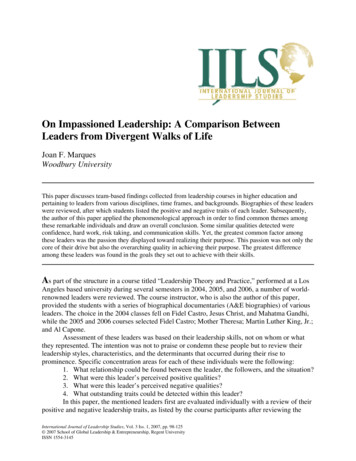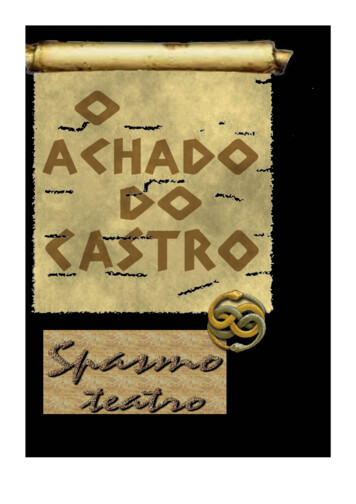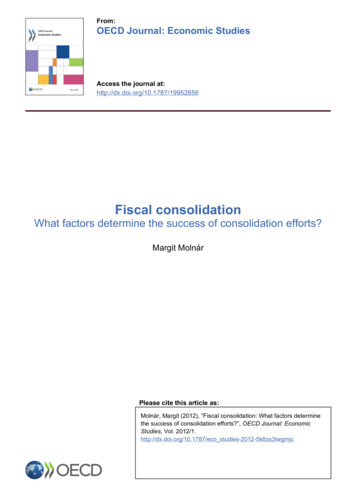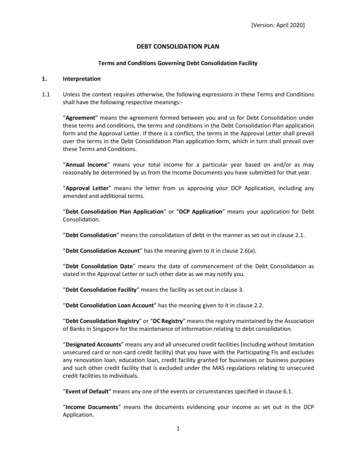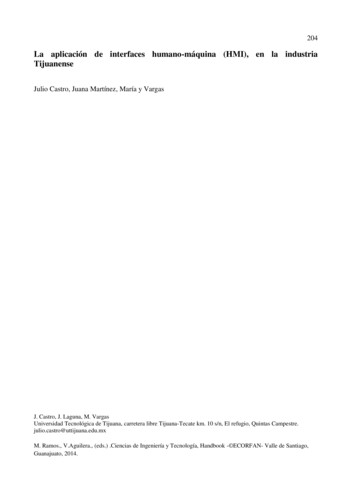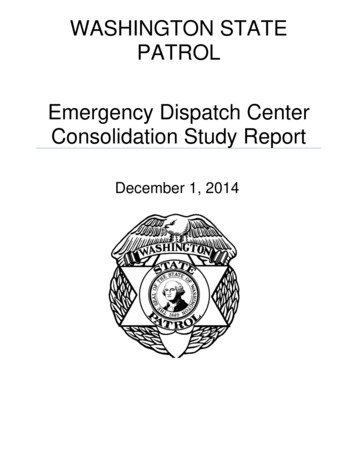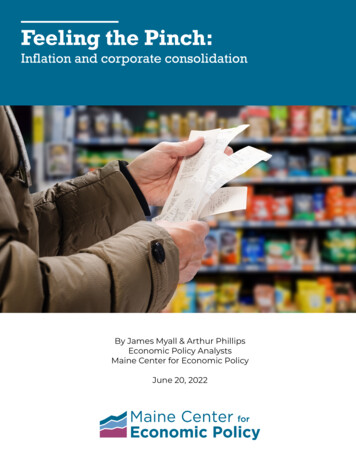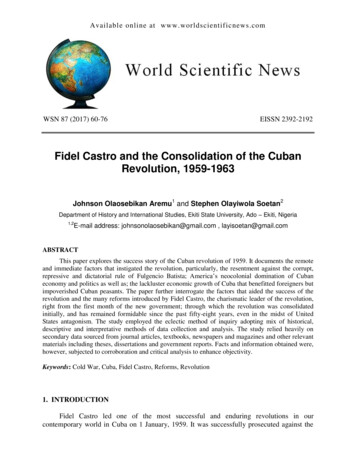
Transcription
Available online at www.worldscientificnews.comWSN 87 (2017) 60-76EISSN 2392-2192Fidel Castro and the Consolidation of the CubanRevolution, 1959-1963Johnson Olaosebikan Aremu1 and Stephen Olayiwola Soetan2Department of History and International Studies, Ekiti State University, Ado – Ekiti, Nigeria1,2E-mail address: johnsonolaosebikan@gmail.com , layisoetan@gmail.comABSTRACTThis paper explores the success story of the Cuban revolution of 1959. It documents the remoteand immediate factors that instigated the revolution, particularly, the resentment against the corrupt,repressive and dictatorial rule of Fulgencio Batista; America’s neocolonial domination of Cubaneconomy and politics as well as; the lackluster economic growth of Cuba that benefitted foreigners butimpoverished Cuban peasants. The paper further interrogate the factors that aided the success of therevolution and the many reforms introduced by Fidel Castro, the charismatic leader of the revolution,right from the first month of the new government; through which the revolution was consolidatedinitially, and has remained formidable since the past fifty-eight years, even in the midst of UnitedStates antagonism. The study employed the eclectic method of inquiry adopting mix of historical,descriptive and interpretative methods of data collection and analysis. The study relied heavily onsecondary data sourced from journal articles, textbooks, newspapers and magazines and other relevantmaterials including theses, dissertations and government reports. Facts and information obtained were,however, subjected to corroboration and critical analysis to enhance objectivity.Keywords: Cold War, Cuba, Fidel Castro, Reforms, Revolution1. INTRODUCTIONFidel Castro led one of the most successful and enduring revolutions in ourcontemporary world in Cuba on 1 January, 1959. It was successfully prosecuted against the
World Scientific News 87 (2017) 60-76military-oligarchic junta of Fulgencio Batista. The basic aim of this research work is to lookat the process of consolidation of the Cuban revolution between 1959 and 1963. The specificgoals are to: analyse the enabling factors that precipitated the Fidel Castro’s led 1959revolution; document the reforms introduced by Fidel Castro in the first-five years of therevolution; look at the challenges, both internal and external, that contended with the survivalof the revolution and; highlight the various issues that aided the success of the revolutionduring the period of study.It needs be recalled that until 1898, Cuba was ruled by Spain since the 16th century. In1898, after the defeat of Spain by America in the Spanish-American War, the Island wasceded to the United States of America (U.S.). She became an independent republic on 20May, 1902 (Europa 1987). But then, her military defence was bound to the U. S. A. by thePlatt Amendment of 1901 which granted the U.S. Navy a coaling station (base) atGuantanamo Bay (Encyclopaedia Britannica, 2013). It further granted the U.S. the right tointervene and restore peace in Cuba when such request is made by the president.Apart from political control, Cuba also gradually became ‘an economic colony of theU.S.A.’ As at 1950, the U. S. alone owned about half of the total 1 billion foreigninvestment in Cuba. Multinational corporations have almost seized control and initiative ofthe Cuban economy. Unfortunately, the masses did not benefit from the massive economicgrowth propelled by increasing rate of foreign investment. Only a few citizens of Cuba andsome foreign companies reaped the fruit of industrialization. The need to correct thisabnormality and redistribute wealth largely propelled the 1959 revolution.To compound the already battered situation, General Fulgencio Batista Zaldivar whohad earlier ruled from 1933 to 1944 staged a comeback in March 1952, when, in a bloodlesscoup, he toppled the democratic government of President Carlos Prio Socarras (Slee, 2008: 89). He set up a dictatorial government that was pro-America. His government soon becameharshly repressive, corrupt and unpopular.2. A SHORT POLITICAL HISTORY OF CUBACuba was reportedly discovered by Christopher Columbus in 1492 (EncyclopædiaBritannica, 2013). Soon after that, it became a Spanish colony used largely as a rest stop forSpanish ships ·travelling between Spain and the other Spanish colonies (Rogers, 1974: 7).The first revolt against Spanish rule lasted from 1868 to 1878. It was motivated by thedesire for self-government combined with hopes for an end to slavery. By 1878, the Spanishcolonial power agreed to free the slaves, but declined from granting the colonists’ selfgovernment. The colonists’ had to wait till 1895 before they could garner enough confidenceand military strength to organize another revolt led by Jose Marti, a Cuban nationalistintellectual that had lived in exile in the U.S. (Rogers, 1974: 2). The clamour then was tocreate an independent republic of Cuba (Frank, 1965: 1102). Though, he died while leading agroup of guerrillas against the Spanish, he became a national hero whose ideas formed thebasis for the Cuban nationalism in the years to come (Ruiz, 1968:20 cited in Rogers, 1974: 2).By 1898, after a bloody struggle with the Spanish soldiers, the Cuban rebels had comeclose to victory. It was at this point that the American government decided to interveneactively by sending troops to Cuba to defeat the Spanish (Wolf, 1969: 254 cited in Rogers,1974: 2; Frank, 1965: 1102). Once the war was over, the Americans almost replaced the-61-
World Scientific News 87 (2017) 60-76Spanish as the villains for Cuban nationalists, though they agreed to the founding of theCuban republic, and eventually withdrew their troops. The Platt Amendment of 1901, whichallowed for further American intervention in Cuban domestic affairs, at its pleasure, wasincorporated into the new constitution (Frank, 1965: 1102). Its presence reinforced the antiAmerican feelings of the nationalists, especially when it was used to bring U.S. troops back toCuba several times between 1902 and 1920 (Ruiz, 1968: 24, 33). But even after the PlattAmendment was abrogated in 1934, the possibility of American interference was always aconsideration (Rogers, 1974: 3).3. THE INVOLVEMENT FIDEL CASTRO IN CUBAN POLITICS BEFORE 1959Fidel Castro Ruz was born on 13 August, 1926 at Biran, Oriente province of Cuba(Prevost, 2007: 19). He was educated at Jesuit institutions, Colegio La Salle andColegioDolopes in Santiago and finally Colegio Belen in Havana (Prevost, 2007: 19). Helater proceeded to the University of Havana where he bagged a degree in law in 1950 (Slee,2008: 11). Upon his graduation, he joined the services of a small law firm that defended thepoor and people with political difficulties (Prevost, 2007: 19; Nosotro, 2003).Castro’s active involvement in Cuban politics started in 1950 when he joined the CubanPeoples Party (also known as the Ortodoxos Party) which was in opposition to FulgencioBatista’s ruling Authentic Party (Prevost, 2007: 19; Slee, 2008: 11). Castro was chosen to be aparliamentary candidate of the Ortodoxo Party in elections planned for May 1952 but theelections were cancelled after Batista’s coup of 10 March, 1952 (Frank, 1965: 1102) It isinstructive to note that Castro instituted a legal battle to challenge the Batista’s coup as aviolation of the Cuban Constitution of 1940. The failure of this legal act to bring a redressinvariably invigorated Castro’s revolutionary instinct that quickly began preparations for anarmed uprising. Slee (2008: 14) reports that for this purpose, “he (Fidel Castro) recruited 1200young people, mainly drawn from the Ortodoxo youth, and gave them some very elementarymilitary training”. On 26 July, 1953, Castro led a revolt of radical opposition group againstBatista's government at the Moncada barracks in Santiago (Pedraza, 2009: 2; Rogers, 1974:9). The attack was intended to spark a general insurrection throughout the island.The revolt failed. Consequently, a real number of the attackers died. Fidel Castro, hisbrother, Raul Castro and many of his followers were captured, tried and jailed (Asprey, 1975:695-698). Nosotro (2003) reports that Castro deployed his years in jail to study politicalphilosophy, history and literature which strengthened his revolutionary philosophy.During histrial, Fidel Castro delivered his four hours famous speech titled: “History Will Absolve Me”.The speech, which represented nothing more than an impassioned critique of the Batistaregime, called for greater political and social liberties. The speech eventually became therallying cry of the July 26th Movement, and since 1959; July 26 has been celebrated asCuba’s most important national holiday and the occasion of a major speech by Fidel Castro(Prevost, 2007: 20).But for reasons best known to Batista, Castro and his cohorts were released and grantedState pardon on 15 May 1955 (Slee, 2008: 14; Rogers, 1974: 9). On 7 July, 1955, Castro leftCuba and went to Mexico on self-exile where he formed a revolutionary movement christened"The 26th of July Movement" for the overthrow of Batista (Greenblatt, nd: 650). At Mexico,he and his followers carried out military training in preparation for a return to Cuba to-62-
World Scientific News 87 (2017) 60-76overthrow the dictatorial government of Batista. While in Mexico, Argentinean doctorErnesto “Che” Guevara,joined the movement to give more bite to the revolutionary force(Slee, 2008: 14).On 2 December, 1956, they set sailed for Cuba on the second attempt at revolution. It,however, turned out to be a failure. Sixty-eight of the eighty-two members of therevolutionaries died. The remnant of the troop fled into the remote Sierra Maestra mountainsto continue their struggle (Prevost, 2007: 20; Pedraza, 2009: 2). Thereafter, Fidel Castro andhis group engaged guerrilla warfare against local army outposts. Most attacks were successfuland the needed weaponry was stolen from the army. Batista’s regime collapsed after aprolonged struggle in 1959. Commanding an overwhelming support from the students andpeasants, Castro and his forces (thefidelistas) occupied Havana on I January, 1959 (Frank,1965: 1105). Batista fled the country immediately (Lewis-Beck, 1979: 1134; Karol 1970,572). A revolution whose major aims were to destroy all privileges, remove exploitation andcreate a just society had taken place. A new government emerged with Fidel Castro as itsPrime Minister (Slee, 2008: 14).4. CAUSES OF THE CUBAN REVOLUTION OF 1959Fisher’s (2011) submission that “revolutions are explosion of frustration and rage thatbuild over time, sometimes over decades” rightly captures the reality of the remote andimmediate factors that culminated in the 1 January, 1959 revolution in Cuba, some dating toas far back as 1898. The first, which is political, was the autocratic rule of Batista. The longand brutal dictatorship of General Fulgencio Batista (1933–44 and 1952–58), which had beenintolerant of opposition had become intolerable to the masses of Cuba. His highly personalistand oligarchic style of administration drove many people in opposition to his government.However, the immediate cause that instigated the 1959 revolution was the truncation ofdemocratic political process by Batista in 1952. Pedraza (2009:2) submits that Cubans whofought for the revolution were against Batista’s dictatorship and wanted to restore therepublic, namely, the constitutional elections that General Fulgencio Batista’s 1952 coup hadbroken. But more importantly, Fidel Castro was nominated as the Orthodox Party candidatefor Congress election of 1952. However, the elections were cancelled by Batista. Castro’schallenge of the legality of Batista’s coup also failed in court. Castro responded by forming arevolutionary group (Prevost, 2007: 19). TheCuban Revolution may thus be said to haveundoubtedly grew out of the dictatorial repression of Batista.The second factor advanced for the revolt was the lackluster economic growthwitnessed by Cuba during Batista's reign and the wish to shake-off American grip over theCuban economy. Lotta (2006) and Prevost (2007: 24-25) report that by the 1950s, the UnitedStates had an estimated 1 billion investment in Cuba. The U.S. companies controlled 80percent of Cuban utilities, 90 percent of Cuban mines, close to 100 percent of the country’soil refineries and 90 percent of its cattle ranches. But most importantly, U.S. companiescontrolled 40 percent of the sugar crop and 55 percent of the sugar mill capacity; and were themajor buyer of Cuban sugar. In return for preferential entry of its sugar into U.S. markets,Cuba was further required to open its market to U.S. manufactured goods. This had a negativeeffect on the growth of local firms in Cuba. Given such an intimidating statistics of Americanrole in the Cuban economy, it is apt to agree with Lotta (2006) and Prevost (2007: 24-25) that-63-
World Scientific News 87 (2017) 60-76Cuba had gradually turned to an economic colony of the United States as the latter was tookinitiative for Cuba's economic development. Cuban radicals as well as the poor masses werefed up with resentment to this high dependence on the U. S. This served as the backdrop forthe Cuban revolution of 1959 (Lotta, 2006). The essence of the revolution here was to shakeoff American grip on Cuban economy and promote an economic indigenisation policy in thecountry.The rampant scourge of corruption was another feature of the Cuban political economy(Prevost, 2007: 19). Right from 1909 under the administration of José Miguel Gómez (19091913) and through the governments of Mario GarcíaMenocal (1913–21), Alfredo Zayas(1921–25), Gerardo Machado y Morales (1925–33), Fulgencio Batista (1933–44 and 1952–58), Ramón Grau San Martín (1944–48), and Carlos PríoSocarrás (1948–52); Cuba may besaid to have lived under the curse of corrupt leadership (Encyclopaedia Britannica, 2013).Public funds meant for State administration were siphoned into private purses of the leadersand their cronies. The net effect was that the Cuban economy was starved of funds fordevelopment, just as the nation experienced infrastructural negligence and decay (Slee,2008:6; Encyclopaedia Britannica, 2013). The need to wipe out corruption, therefore, becameone of the corner stones of the Cuban revolution in 1959. In other words, the CubanRevolution, which began in the early 1950’s, was regarded as an overthrow of a very corruptgovernment. It was trying to improve the conditions of the Cuban people by eliminating themonster of corruption which had been a clog in the will of socio-economic development.The twin problems of rampant unemployment and abject poverty among the peasantsmay also be held responsible for the outbreak of, and massive support for, revolution in Cubain 1959. It is true that the Cuban economy showed signs of growth and wealth on the eve ofthe revolution, especially given a high GDP recorded by the economy as well as the physicalpresence of huge industries spread across the country between 1940 and 1952; yet it was clearthat the predominantly peasant population was probably not benefitting much from thiseconomic growth. Hence, although Batista and his friends in the corridors of power wereworth millions of dollars, the average Cuban lived in poverty and ill-health. In Cuba, 600,000out of 3,000,000 Cubans were unemployed. Apart from this, over half of the population livedin huts, shacks and slums, without the slightest sanitary facilities. In short, the thrivingeconomy only enriched a few Cubans while most people experienced abject poverty.Consequently, they were desperate to see an improvement in their lifestyle. This probablyexplains why the people supported Castro and his revolutionary group wholeheartedly.5. REFORMS INITIATED BY FIDEL CASTROWhen Fidel Castro and his revolutionary group took control of the Cuban governmentin 1959, it was just a matter of time for Cubans to witness spectacular changes andtransformations in the nations’ social, economic and political destinies. Some of theformidable reforms implemented by Castro are examined below.a. Economic ReformsThe first major economic reform initiated by Fidel Castro was to nationalise all foreigninvestments in Cuba, particularly of the US, without compensation (Boline, 2015). As a resultof the socialist tendencies exhibited by the new revolutionary government, US owned-64-
World Scientific News 87 (2017) 60-76refineries in Cuba refused to process Soviet crude oil. (Slee, 2008: 27). The Cubangovernment responded by taking over the refineries. Slee (2008: 27) and Prevost (2007: 24)agree that confrontation over the oil refineries resulted in the first nationalizations in July1960, and they were followed quickly by the seizure of U.S.-owned sugar plantations inAugust, foreign banks in September, and more businesses in October (Prevost, 2007: 24).Eventually, all United States' business interests were expropriated in October 1960 (Rogers,1974: 11). This particular step was no doubt an exhibition of Castro's determination to oustU.S. ‘dollar imperialism’ in Cuba (Brown and Mooney, 1976: 79; Perry, 1980:711; Roehn,1965: 58). Brown and Mooney (1976: 80) report further that by then, "the only foreigninvestments of importance in Cuba were those of the U.S.". American participation in thetelephone and electric services, the public service railways and sugar production wereestimated to be about 90%, 50% and 40% respectively. Cuba indeed ranked third in LatinAmerica in the value of U. S. direct investments (ibid).As expected, Castro's nationalisation policy provoked U.S. reaction. She retaliatedinitially by cutting off Cuban sugar imports into the US and in January 1961, theEisenhower’s administration instituted an embargo on most exports to Cuba (Rogers, 1974:11). In response, Cuba and the Soviet Union signed a trade agreement in February 1960 inwhich the Soviet Union agreed to buy sugar and other items from Cuba and to supply Cubawith crude oil (Garvin, 2016). In furtherance of US opposition to the Cuban revolution, theUS Congress passed the Foreign Assistance Act on 1 August, 1962, including an amendmentbarring aid to “any country which furnishes assistance to the present government of Cuba.”This provision was further amended in 1963 to withhold foreign aid from countries that allowships under their flag to carry goods to or from Cuba (Krinsky and Golove 1993, 112–13).Furthermore, in February 1963, the US government enacted a law which prohibited shipmentsof cargoes paid for by the US government on foreign-flag ships that have called on a Cubanport. Maritime unions were also encouraged to boycott ships named on US governmentblacklist because of their trade with Cuba (Krinsky and Golove 1993: 112–13 cited inHufbauer et al., 2011: 2).On the advice of US State Department, US oil firms in Cuba stoppedrefining oil purchased from USSR. Sooner, Castro, feeling unperturbed, began a process ofrapid industrialization. The plan soon gave way to more realistic concerns as there wasincreased sugar, agricultural and mineral production courtesy of aids from the USSR.Castro also introduced a good number of pro-poor policies to give the masses a newlease of life. For instance, the Agricultural Reform Act was earlier signed into law in May1959. The Act limited the size of most farm holdings to fewer than 1,000 acres. As against theinitial 3000 acres. The new law ensured that land was distributed to thousands of hithertolandless rural workers. Government went ahead to improve conditions on the farms.Similarly, Government passed the Rent Reduction Act in 1959 which resulted in the transferof about 15 percent of the national income from property owners to wage workers andpeasants (Prevost, 2007: 25). These two regulations indeed represented a bold attempt byFidel Castro to redistribute wealth in Cuba. This went a long way to stimulate masses’ supportfor the revolution across the nooks and crannies of the country.b. Social ReformsA number of social reforms were initiated by Fidel Castro in the educational, health,housing and social security sectors of Cuban life.-65-
World Scientific News 87 (2017) 60-76bi. Education sectorThe first in the series was the introduction of free and adult literacy programme tocombat the problem of widespread illiteracy. Without mincing words, Fidel Castro’sdeclaration that “there can be no revolution without education because a revolution meansprofound changes in the life of a country” underscores the basic philosophy of Cubaneducational reform after the revolution (Castro, 1961 cited in Steinborn, 2014: 13).Steinborn (2014); Carnoy (1990) and Schwab (1999) have indeed identified some of thebasic aims of Castro’s education reforms in the immediate post-revolutionary era to include,but not limited to: education as a lever and leveler especially for the down-trodden masses;education as a tool for constructing a national culture as a means of arming the masses againstU.S. influence; education as a tool for enhancing Cuba’s global legitimacy as an autonomousnation and for influencing domestic change regarding the transition from U.S.-controlledcapitalism to socialism following the revolution and; education for social transformation.6. COMPONENTS OF CASTRO’S EDUCATIONAL REFORMOne of the major provisions of Cuba’s educational reform was equal access to educationfor all citizens irrespective of race, class or gender. Indeed, education became free andavailable to all (Slee, 2008: 30). All citizens were given full access to schools. Adults andchildren in urban and rural settings – people from all walks of life, many of whom previouslyfaced restrictions in their ability to access high quality schools and who hitherto could notadvance beyond grammar school – were welcomed into this system. This system domesticallymarked Cuba as wholeheartedly different from pre-revolutionary times, when schools wereprivatized and hierarchical, privileging the upper classes and restricting proletarian education.Cuba thus pushed constantly towards complete equality, equity, and accessibility. This systemmade Cuban education competitive on an international scale, since it provided a strongeducation to all students in all parts of Cuba, even the remote mountains and sugarcane fields(Steinborn, 2014: 15-16).The second provision of the education reform was making the teaching profession morelucrative as Castro referred to the teachers as “the great army of education in our country”(cited in Steinborn, 2014: 13). Teaching was considered foundational to the entirerevolutionary transformation of Cuban culture, which Castro rooted explicitly in education.Hence, Castro invigorated the teaching profession in order to draw more people into theteaching force. Government prioritized teacher education and embarked on training thousandsof additional teachers (Slee, 2008: 30; Prevost, 2007: 21). Cuba education also emphasizedspecialisation by discipline which increased the functionality of teachers (Steinborn, 2014:17). Great incentives were provided for teachers as they “paralleled military generals in theway that they functioned in the cultural battle of communism against imperialism, becausethey directed the knowledge and resultant behaviors of the Cuban people” (Steinborn, 2014:17).Thirdly, Castro universalised schooling across the length and breadth of Cuba. Thisideal of began during the hey days of the Cuban Revolution as guerilla fighters taughtpeasants in liberated zones (Steinborn, 2014: 18). It became heightened when he convertedthe Batista regime’s bases into schools following the 1959 victory. Early revolutionaryeducation then took place in bohios (peasant huts). This system was effectively managed to-66-
World Scientific News 87 (2017) 60-76disperse knowledge to underprivileged Cubans in underdeveloped areas (Steinborn, 2014:18).Through the 1961 Literacy Campaign programme, Castro succeeded in mobilizingrevolutionary troops to provide the illiterate population with reading and writing skills so thatthe revolution could take root in the minds of all Cubans (Steinborn, 2014: 18). As Carnoy(1990: 174-175) noted in his pedagogical analysis of Cuban education following therevolution, universalising participation greatly assisted Cuba to actualize its socialist goals. Itis essential to add that private schools were abolished in Cuba in 1961. Before then, only therich whites attended the well-equipped private schools while the blacks and some poor whitesattended the under-financed public schools. After the abolition of private schools, the bulk ofCuban students started attending fully integrated schools where blacks and whites receivedequal treatment.Another unique feature of Cuban educational reform was the invention of workplaceschools and rural schools which furthered the trend of universalising the location of educationso that it would pervade Cuban social spaces. As a complementary project, the governmentalso embarked on rigorous construction of new schools (Slee, 2008: 30; Prevost, 2007: 21).Explaining the rationale for this, Castro said: “in the future, practically every plant,agricultural zone, hospital, and school will become a university” (Read, 1975: 217).Plantation mansions – referred to as fortresses by Castro, used to keep commoners away fromwealthy estate owners before the revolution –which dotted the rural areas of Cuba, wereconverted to schools for rural workers and their children. This extraordinary emphasis oneducation, according to Schwab (1999: 159), “has given Cuba a literacy rate above 96percent, by far the highest in Latin America”. In his estimate, the rate of illiteracy in Cubareduced drastically from 23.6 percent to 3.9 percent in less than one year of the reform.bi. Housing ReformIn an attempt to enhance the human dignity of average Cubans, Castro also introducedreform in the housing sector witnessing the launching of low - cost housing schemes. Itinstituted an immediate 50 percent reduction in rent and eventually government granted theformer tenants ownership of the houses. Thus, the most visible impact of the programmeaccording to Dzidzienyo and Casal (1979) was that more blacks as a percentage of thepopulation own their homes in Cuba than in any country in the world.Through the 1960 Urban-Reform law, government eliminated multiple ownership ofland and gave renters a chance to buy their homes at low-cost. Government also took a boldstep to curtail speculation by requiring private owners to sell sites at low uniform prices toanyone willing to start construction. The State assumed responsibility for providing housingfor all. Cuban law prohibits homeowners from selling their homes privately or buyingproperties because Castro believed land speculation violates socialist principles (Kapur &Smith, 2002: 5). The Urban Reform Law further converted half of urban tenants intohomeowners, and many tenants were given long-term rent-free leases. Some others were alsogranted leases on all units built or distributed by the government after 1961 at no more than10% of household income. Ownership of the units was conferred after 5-20 years of payment(Kapur & Smith, 2002: 5). This policy promoted a better life and good comfort for therelatively economically weak and poor Cuban citizens. Most former owners were eventuallyfully compensated for their losses, but landlords of slum tenement buildings received nothingfrom the government (Kapur& Smith, 2002: 5).-67-
World Scientific News 87 (2017) 60-76Meanwhile, the housing bill prohibited private renting and subletting, and it was illegalfor households to own more than one primary residence and one vacation home (Hamberg,1990: 235-250; Kapur & Smith, 2002: 5).In addition, the government initiated an extensive programme of construction of newhouses in the rural areas where owner-occupants made loans and technical assistanceavailable for private construction. The programme raised the housing conditions of many.Government also redistributed elegant homes left by wealthy Cubans who fled the countryamong poorer residents.bii. Health Sector ReformReform in the health sector after the revolution was multi-dimensional. In the firstinstance, government extended health care to the entire population for the first time with byconstructing rural clinics and hospitals across the country (Prevost, 2007: 21). Prior to therevolution, only the affluent members of the society had access to adequate medical treatment.But under the new health reform, health care became free and available to all.The basic aim of the new health policy was to improve the health care delivery systemof Cuba so that the masses might have direct and easy access to health facilities and thusenhance long life of citizens. Deliberate attempts were, therefore, made by government to setup new health centers while the existing ones were refurbished. Government also made hugeinvestments in training health staff in the country (Slee, 2008: 30).The reform yielded positive results. For instance, Hague and Harrop (1987: 305)reported that by 1971, 90% of Cuban population lived within 'an hour' of a health care facilitywhile in the same period, about 30% of Cuban University students were studying medicine onfull scholarship. As a result, the health system of the Cuban population has been positivelytransformed since the 1959 revolution.Other social reforms introduced by Castro included: elimination of all discrimination onthe basis of race or sex, ameliorating extreme social inequality and enforcing honesty andprobity in public service through the confiscation of assets gained by fraud (Slee, 2008: 28).The reason for this was to cut the incidence of corruption that had eaten deep into the fabricsof the society under Batista (Perry, 1980: 711; Lotta, 2006). Some productive assets were alsoplaced in the hands of the State by confiscating assets gained by fraud.c. Military reformCastro undertook a major rest
Fidel Castro Ruz was born on 13 August, 1926 at Biran, Oriente province of Cuba (Prevost, 2007: 19). He was educated at Jesuit institutions, Colegio La Salle and ColegioDolopes in Santiago and finally Colegio Belen in Havana (Prevost, 2007: 19). He later proceeded to the University of Havana where he bagged a degree in law in 1950 (Slee, .


